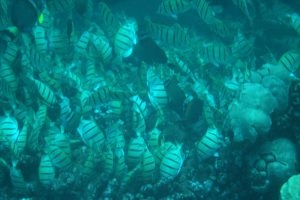By The Numbers: Disappearing Fish
90%. That’s the staggering amount of forage fish caught globally that are used for non-human activities such as providing fishmeal for aquaculture—fish farms—and agriculture, pigs and chickens. Other uses include fish oil for Omega-3 oils and pet food. Human consumption is limited.
 A 13-member task force surveying worldwide forage fish populations suggests cutting the fishing rate by half to encourage renewal of the vulnerable fish and protect the predators that eat them. The task force report, “Little Fish, Big Impact” also calls for doubling the minimum biomass (the amount of fish by weight) of forage fish that must be left in the water.
A 13-member task force surveying worldwide forage fish populations suggests cutting the fishing rate by half to encourage renewal of the vulnerable fish and protect the predators that eat them. The task force report, “Little Fish, Big Impact” also calls for doubling the minimum biomass (the amount of fish by weight) of forage fish that must be left in the water.
Forage fish are easily caught because they form dense schools and include sardines, anchovies, menhaden and herring. “Forage fish play a crucial role in marine food webs, preying on plankton and transferring energy up to marine mammals, seabirds and larger fish,” the report says, adding that conventional management did not “capture the critical role of forage fish as food for marine mammals, seabirds and commercially important fish such as tuna, salmon and cod.”
Ellen Pikitch, Ph.D., at the Institute for Ocean Conservation Science at Stony Brook University, convened the task force and says: “Forage fish comprised just 8% of the global catch in the 1950s, whereas today they comprise 37%.
There’s money in keeping the fish in the water. A chart in the report shows the global value of forage fish remaining in the water as prey is twice as valuable at $11.3 billion as forage fish obtained for commercial activities, valued at $5.6 billion.
“Forage fish fill a niche as the forage base for other predatory fish higher on the food chain,” says Robert Beal at the Atlantic States Marine Fisheries Commission. Beal, director of interstate fisheries management, watches over the Atlantic menhaden and herring.
Associate Professor Selina Heppell in the Department of Fisheries and Wildlife at Oregon State University, notes that forage fish provide food for seals and sea lions as well as birds such as puffins. Heppell, a task force member, says she does not believe consumers will have difficulty purchasing wild fish at the store. “The species of fish and the amount you will have to pay may change,” she adds.
“Aquaculture is the fastest growing food sector, growing at about 9% a year,” says Geoff Shester, California program director for Oceana (oceana.org), a nonprofit advocacy organization. Shester says that the total amount of forage fish removed from the ocean has remained relatively stable over the past decade, but due to declines in many of the larger fisheries, forage fish today represent a much larger share of the total catch.
Shester says that the vast majority of pacific sardines harvested off the west coast in the U. S. are sold to bluefin tuna farms or to international commercial long line fleets targeting tuna. Only a small percentage goes to human consumption. Because aquaculture use is increasing, he says that the overall price of fishmeal and fish oil will probably increase. The result: Forage fish species that were not viable will become attractive.
The Pacific Fishery Management Council doubled the quota allowed for sardines in the face of a declining stock, says Shester, adding: “This is a clear case of short-term gains for one economic sector at the costs to our fisheries and ecosystem.”

